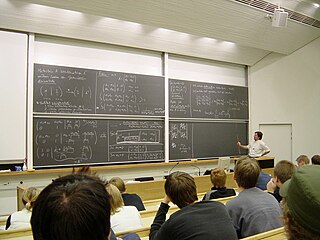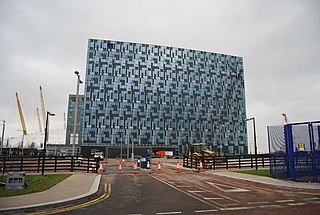Related Research Articles

In contemporary education, mathematics education—known in Europe as the didactics or pedagogy of mathematics—is the practice of teaching, learning, and carrying out scholarly research into the transfer of mathematical knowledge.

Upward Bound is a federally funded educational program within the United States. The program is one of a cluster of programs now referred to as TRiO, all of which owe their existence to the federal Economic Opportunity Act of 1964 and the Higher Education Act of 1965. Upward Bound programs are implemented and monitored by the United States Department of Education. The goal of Upward Bound is to provide certain categories of high school students better opportunities for attending college. The categories of greatest concern are those with low income, those with parents who did not attend college, and those living in rural areas. The program works through individual grants, each of which covers a restricted geographic area and provides services to approximately 59,000 students annually. The program focuses on academic and nonacademic resources and activities like visits to museums or tutoring for school work. Students are encouraged to be involved in Upward Bound for the entire academic year and a 6-week long summer program. Many students who are also granted access into the Upward Bound program are labeled as first generation college students, who are students that are the first in their family to attend college. This program is set in place for students who come from low income families as well as underrepresented schools and gives them an opportunity to excel in college.
Mathematics, Engineering, Science Achievement (MESA) is an academic preparation program for pre-college, community college and university-level students. Established in 1970 in California, the program provides academic support to students from educationally disadvantaged backgrounds throughout the education pathway so they will excel in math and science and ultimately attain four-year degrees in science, technology, engineering or math (STEM) fields. The program has successfully been replicated in over a dozen other states.
Julian Cecil Stanley was an American psychologist. He was an advocate of accelerated education for academically gifted children. He founded the Johns Hopkins University Center for Talented Youth (CTY), as well as a related research project, the Study of Mathematically Precocious Youth (SMPY), whose work has, since 1980, been supplemented by the Julian C. Stanley Study of Exceptional Talent (SET), which provides academic assistance to gifted children. Stanley was also widely known for his classic book, coauthored with Donald Campbell, on the design of educational and psychological research - Experimental and Quasi-experimental Designs for Research.

Science, technology, engineering, and mathematics (STEM) is an umbrella term used to group together the distinct but related technical disciplines of science, technology, engineering, and mathematics. The term is typically used in the context of education policy or curriculum choices in schools. It has implications for workforce development, national security concerns, and immigration policy, with regard to admitting foreign students and tech workers.

Teach First is a social enterprise registered as a charity which aims to address educational disadvantage in England and Wales. Teach First coordinates an employment-based teaching training programme whereby participants achieve Qualified Teacher Status through the participation in a two-year training programme that involves the completion of a PGDE along with wider leadership skills training and an optional master's degree.

The Faculty of Technical Sciences is a higher education institution located in Novi Sad, an independent part of the University of Novi Sad. It was founded on 18 May 1960 and today it is the largest faculty in Serbia by number of students and one of the largest in the region. As of 2020–21 academic year, it has a total of 15,742 students.
The Science, Technology, Engineering and Mathematics Education Program is a science and mathematics-oriented curriculum devised for high schools in the Philippines. The STEM program is offered by specialized high schools, whether public or private, supervised by the Department of Education. Currently, there are 110 high schools offering the STEM program, the majority being public. It was piloted in 1994 by the Department of Science & Technology (DOST).

Sex differences in education are a type of sex discrimination in the education system affecting both men and women during and after their educational experiences. Men are more likely to be literate on a global average, although higher literacy scores for women are prevalent in many countries. Women are more likely to achieve a tertiary education degree compared to men of the same age. Men tended to receive more education than women in the past, but the gender gap in education has reversed in recent decades in most Western countries and many non-Western countries.
Teach to One, previously known as School of One (SO1), is a middle school mathematics program of the New York City Department of Education. It began in 2009 and is currently operating in six schools in Manhattan, The Bronx, and Brooklyn. Its innovative program integrates the use of technology in the development and implementation of personalized curriculum and learning as well as the use of technology in the learning environment.
Mathematics and Science Partnerships (MSP) is education policy from Title 2, Part B, Sections 2201-2203 of the No Child Left Behind Act of 2001. The purpose of MSP is to increase student achievement in science and mathematics by partnering IHE science, math, and engineering departments with elementary and secondary science and math teachers in high-need local educational agencies (LEAs) in order to develop teachers' content knowledge and instructional performance. SEAs may apply for competitive grants and then IHEs and LEAs may apply for a subgrant of the SEA.

Many scholars and policymakers have noted that the fields of science, technology, engineering, and mathematics (STEM) have remained predominantly male with historically low participation among women since the origins of these fields in the 18th century during the Age of Enlightenment.
Computer-Based Math is an educational project started by Conrad Wolfram in 2010 to promote the idea that routine mathematical calculations should be done with a computer.
Professor Tom Lowrie was appointed a Centenary Professor at the University of Canberra, Australia, in 2014. He has an established international research profile in the discipline area of STEM education and mathematics education.
The STEM pipeline is a critical infrastructure for fostering the development of future scientists, engineers, and problem solvers. It's the educational and career pathway that guides individuals from early childhood through to advanced research and innovation in STEM-related fields.

C-STEM is a UC-approved educational preparation program for undergraduate admission for UC campuses to prepare students for college and career. C-STEM has University of California A-G Program status. High schools can add the A-G approved rigorous C-STEM curriculum to their own school’s A-G course lists for the UC/CSU admission requirements.
Silicon Valley Education Foundation (SVEF) is a non-profit organization serving Silicon Valley. Headquartered in San Jose, California, the SVEF creates resources and programs for students and educators in Silicon Valley in Science, technology, engineering, and mathematics (STEM) fields.
Minerva Cordero Braña is a Puerto Rican mathematician and a professor of mathematics at the University of Texas at Arlington. She is also the university's Senior Associate Dean for the College of Science, where she is responsible for the advancement of the research mission of the college. President Biden awarded her the Presidential Award for Excellence in Science, Mathematics, and Engineering Mentoring (PAESMEM) on February 8, 2022.

Teach For Australia is a not-for-profit organisation which aims to address educational inequity in Australia. The organisation’s Leadership Development Program recruits "university-educated high achievers" to the classroom as teachers, placing them in eligible partner schools serving low socioeconomic communities for two years. Program participants earn a Masters-level degree in teaching during the two-year program, allowing them to continue to work in school settings following the completion of their placement.
Christina Eubanks-Turner is a professor of mathematics in the Seaver College of Science and Engineering at Loyola Marymount University (LMU). Her academic areas of interest include graph theory, commutative algebra, mathematics education, and mathematical sciences diversification. She is also the Director of the Master's Program in Teaching Mathematics at LMU.
References
- 1 2 3 4 5 Watts, Geoff (2004-02-06). "Ambassadors, go forth and multiply". Times Higher Education. Retrieved 2009-03-13.
- 1 2 3 Lucas, Stephen (2004-02-27). "Ambassadors wooed into classes". Times Educational Supplement. Retrieved 2009-03-13.
- ↑ Singh, Simon (2005-10-24). "It doesn't add up". The Guardian. Retrieved 2009-03-13.
- ↑ "UAS: What's been the impact of UAS?". Undergraduate Ambassadors Scheme. Retrieved 2009-03-13.
- ↑ "UAS: How does UAS work?". Undergraduate Ambassadors Scheme. Retrieved 2009-03-13.